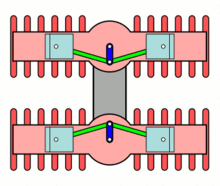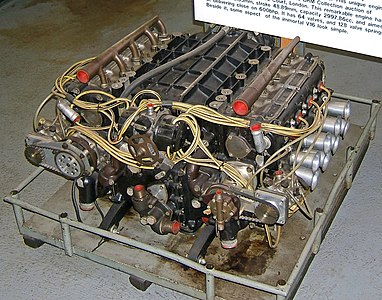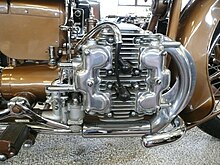
The radial engine is a reciprocating type internal combustion engine configuration in which the cylinders "radiate" outward from a central crankcase like the spokes of a wheel. It resembles a stylized star when viewed from the front, and is called a "star engine" in some other languages.

The Napier Sabre is a British H-24-cylinder, liquid-cooled, sleeve valve, piston aero engine, designed by Major Frank Halford and built by D. Napier & Son during World War II. The engine evolved to become one of the most powerful inline piston aircraft engines in the world, developing from 2,200 hp (1,600 kW) in its earlier versions to 3,500 hp (2,600 kW) in late-model prototypes.

The Napier Lion is a 12-cylinder, petrol-fueled 'broad arrow' W12 configuration aircraft engine built by D. Napier & Son from 1917 until the 1930s. A number of advanced features made it the most powerful engine of its day and kept it in production long after other contemporary designs had been superseded. It is particularly well known for its use in a number of racing designs, for aircraft, boats and cars.

The Porsche 804 is a single-seat, open-wheeled racing car produced by Porsche to compete in Formula One (F1). It raced for a single season in 1962 in the 1½ litre formula.

Coventry Climax was a British manufacturer of forklift trucks, fire pumps, racing engines, and other speciality engines.

British Racing Motors (BRM) was a British Formula One motor racing team. Founded in 1945 and based in the market town of Bourne in Lincolnshire, it participated from 1951 to 1977, competing in 197 grands prix and winning seventeen. BRM won the constructors' title in 1962 when its driver Graham Hill became world champion. In 1963, 1964, 1965 and 1971, BRM came second in the constructors' competition.

A multi-valve or multivalve engine is one where each cylinder has more than two valves. A multi-valve engine has better breathing, and with more smaller valves may be able to operate at higher revolutions per minute (RPM) than a two-valve engine, delivering more power.

The Ford flathead V8 is a V8 engine with a flat cylinder head introduced by the Ford Motor Company in 1932 and built by Ford through 1953. During the engine's first decade of production, when overhead-valve engines were used by only a small minority of makes, it was usually known simply as the Ford V‑8, and the first car model in which it was installed, the Model 18, was often called simply the "Ford V-8" after its new engine. An automotive milestone as the first affordable V8, it ranks as one of the company's most important developments. The engine was intended to be used for big passenger cars and trucks; it was installed in such until 1953, making the engine's 21-year production run for the U.S. consumer market longer than the 19-year run of the Ford Model T engine. It was also built independently by Ford licensees.. The engine was named on Ward's list of the 10 best engines of the 20th century. It was a staple of hot rodders in the 1950s, and it remains famous in the classic car hobbies even today, despite the huge variety of other popular V8s that followed.
The British Racing Motors V16 was a supercharged 1.5-litre V-16 cylinder racing engine built by British Racing Motors (BRM) for competing in Formula One motor racing in the immediate aftermath of World War II. Designed in 1947 and raced until 1954–55, it produced 600 bhp (450 kW) at 12,000 rpm, although test figures from Rolls-Royce suggested that the engine would be able to be run at up to 14,000rpm.

The Rolls-Royce Eagle Mk XXII is a British 24-cylinder, sleeve valve, H-block aero engine of 46 litre displacement. It was designed and built in the early-1940s by Rolls-Royce Limited and first ran in 1944. It was liquid-cooled, of flat H configuration with two crankshafts and was capable of 3,200 horsepower at 18 psi boost.

The Lotus-Ford Twin Cam is an inline-four petrol engine developed by Lotus for the 1962 Lotus Elan. A few early examples displaced 1.5 litres, but the majority were 1.55-litre (1557cc) engines. It used a Ford 116E iron cylinder block and a new aluminium cylinder head with dual overhead camshafts. The Twin Cam was used in a variety of vehicles until Lotus stopped production in 1973. It was succeeded by the Lotus 907 engine.

The Napier Dagger was a 24-cylinder H-pattern (or H-Block) air-cooled engine designed by Frank Halford and built by Napier before World War II. It was a development of the earlier Napier Rapier.

The Napier Rapier was a British 16-cylinder H pattern air-cooled aero engine designed by Frank Halford and built by Napier & Son shortly before World War II.

The 1913 20-cylinder Anzani air-cooled radial engine was the first four row radial and one of the most powerful engines of its period, though few were used.
The Fairey P.16 Prince was a British experimental 1,500 hp 16-cylinder H-type aircraft engine designed and built by Fairey in the late 1930s. The engine did not go into production.
The BRM P115 was a Formula 1 racing car built by British Racing Motors in 1967.
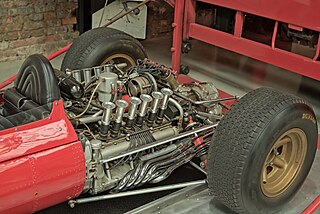
The Ferrari flat-12 engine family is a series of flat-12 DOHC petrol engines produced by Ferrari from 1964 to 1996. The first racing Ferrari flat-12, the Mauro Forghieri-designed Tipo 207, was introduced in the Ferrari 1512 F1 car in 1964. Later flat-12 racing engines were used in Ferrari Formula One and sports racing cars from 1968 until 1980, including the 212 E Montagna, 312 B series, 312 PB and 312 T series. The roadgoing flat-12 engines were introduced with the 365 GT4 BB and were produced in various versions until the end of F512M production in 1996.
German carmaker Porsche built several series of flat-eight engines of differing displacements over the course of many years. They were mainly used in Porsche's racing cars.
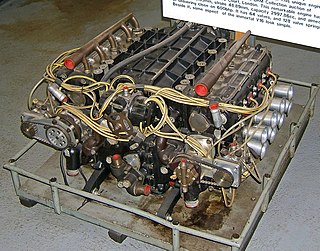
The BRM P75 was a 3-litre H16 motor racing engine, developed by BRM. The engine was relatively competitive but highly unreliable, and was used in Formula One from 1966 to 1968.
The Porsche Type 753 engine is a naturally-aspirated, flat-eight racing engine, designed by Porsche for Formula One racing. It was used for a single season in 1962 in the 1½ litre formula.
